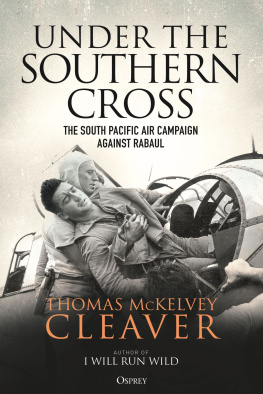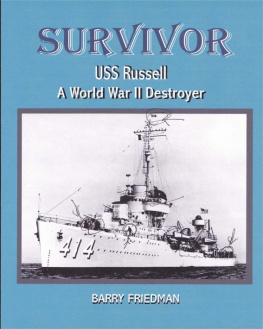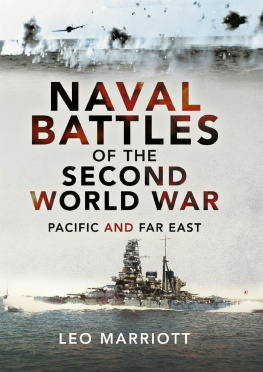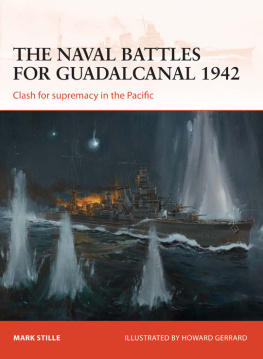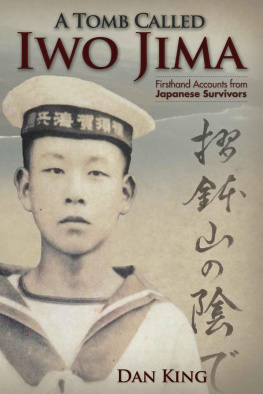


The latest edition of this work has been brought to publication with the generous assistance of Marguerite and Gerry Lenfest.
Naval Institute Press
291 Wood Road
Annapolis, MD 21402
1998 by Russell Sydnor Crenshaw Jr.
All rights reserved. No part of this book may be reproduced or utilized in any form or by any means, electronic or mechanical, including photocopying and recording, or by any information storage and retrieval system, without permission in writing from the publisher.
First Naval Institute Press paperback edition published 2009
ISBN 978-1-61251-550-2 (eBook)
The Library of Congress has cataloged the hardcover edition as follows:
Crenshaw, Russell Sydnor, 1920
South Pacific destroyer : the battle for the Solomons from Savo Island to Vella Gulf / Russell Snydor Crenshaw, Jr.
p. cm.
Includes bibliographical references and index.
1. Maury (Ship) 2. World War, 19391945Naval operations, American. 3. World War, 19391945CampaignsSolomon Islands. I. Title.
D772.M38C74 1998
940.545973dc21 98-14265
98-14265

 Print editions meet the requirements of ANSI/NISO z39.48-1992 (Permanence of Paper).
Print editions meet the requirements of ANSI/NISO z39.48-1992 (Permanence of Paper).
9 8 7 6 6 5 4 3
Contents
The five devastating night battles near Savo Island in the Solomon Islands during the last half of 1942 blunted the cutting edge of both battle fleets facing each other in the South Pacific. The carrier forces had already been decimated by the losses and damage at Coral Sea, Midway, Stewart Island, and Santa Cruz. The flood of Japanese aggression had, however, been stopped, and the tenuous American grip on Guadalcanal finally began to solidify. The price that had been paid by both sides was heavy. Neither adversary knew with any precision the damage done to his antagonist or what residual capability he still possessed. They both stumbled forward into 1943 believing in ultimate victory and making the most of the forces at hand.
Prior to the attack on Pearl Harbor, the U.S. Navy had not fought a battle at sea since the Spanish-American War. Historic isolationism had resulted in ignorance of foreign capabilities and had led to an exaggerated belief in everything American. The men of the Navy believed their ships to be the finest in the world and were confident that the technological marvels with which they were equipped would lead to victory. These men, however, were inexperienced in the realities of war.
Though U.S. industry would manufacture most of the implements of war that ultimately made Allied victory possible in the global conflict, this development and production took time. It would be late 1943 before the new ships and aircraft would reach the battle area in sufficient numbers to make a large difference. By that time, the pivotal battles of the Pacific War had already been fought.
This is the story of those lean months of the Pacific War, when the fate of the Solomons was still in the balance. It is told through the experiences of USS Maury (DD-401), her officers and her crew, who were a part of the South Pacific Force throughout the period and participated in much of the action.
I have endeavored to produce an accurate account of the struggle in the Solomons from the dumbfounding American defeat in the fifth battle of Savo Island (later dubbed the Battle of Tassafaronga) through the vindication of destroyers in the Battle of Vella Gulf I tell the tale as I saw it unfold, from my viewpoint as the gunnery officer and later the executive officer of Maury. I have included a bit of the personalities of the officers and men of Maury to add life and feeling to the discussion of ships, their operations, and their weapons.
It was my intent to record a fascinating segment of the history of the U.S. Navy and to give the reader a feel for what it was really like to be in the South Pacific during the struggle for the Solomon Islands.

AS DAYLIGHT CREPT into the Solomons on the morning of the third of December 1942, a part of the shadowy mass on the west side of McFarland Channel north of Tulagi Island began to detach itself from the jungle. The shape was incongruous with the rounded forms of huge tropical trees and tangled mangrove, but the colors and shadows blended well. As the light improved, the mass seemed to show the outline of shipsthree ships in fact.
The motor torpedo boat mothership USS Jamestown (AGP-3) was moored solidly to the trunks of half a dozen jungle giants bordering the bank where the land dropped off into the deep water of the channel. USS New Orleans (CA-32), one of Americas most powerful heavy cruisers, with her bow blown off to the face of her number 2 triple eight-inch turret, was similarly moored just aft of her. Outboard of New Orleans, with guns pointed skyward at Air Ready, lay our ship, USS Maury (DD-401), a single stack, 1500-ton fleet destroyer.
Camouflage nets had been stretched from the tops of the closest trees ashore over the superstructure of all three ships and fell to the waters edge outboard of Maury. From the surface an observer could see the lower hulls and waterlines as well as the several smaller craft alongside or moored to the bank nearby, but we hoped that from the air the nested ships would look like just another protrusion of the jagged coastline of Florida Island.

Shipbuilders photograph of USS Maury (DD-401). U.S. Navy photo
We were supplying steam and electricity to the damaged cruiser while her crew and a swarm of repair experts from the base on Tulagi Island were struggling to clear the debris left by the titanic explosion of a Japanese torpedo. Because we had been moved forward along the cruisers side so the steam and electrical connections would match up, Maurys bridge was forward of the cruisers bridge and from my station as gun control officer atop the gun director I could look directly down into the tortured wreckage. Wires, pipes, ventilation ducts, scorched and crumpled plates and girders were all tangled together and coated with a sheen of fuel oil. There was no blood and gore evident, but I hesitated to look too closely. Oil fumes, combined with the bitter odor of burned rubber, added to the pungent odors of the drenched jungle and the mangrove-covered mud flats.
Next page

